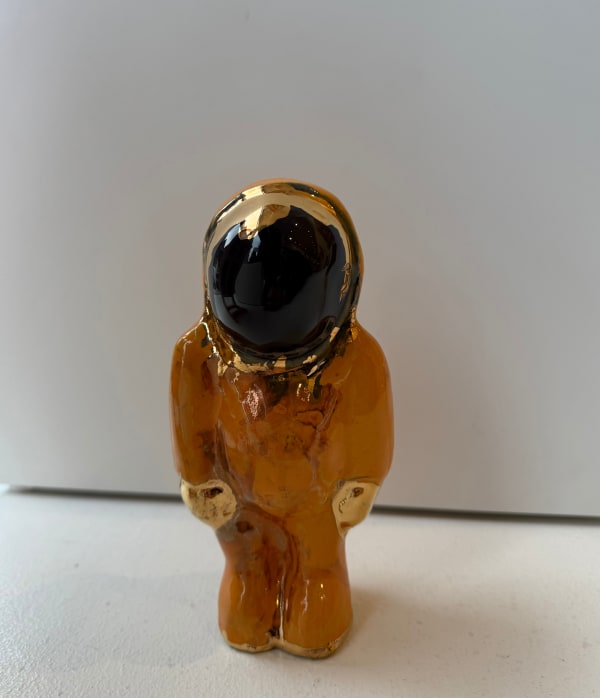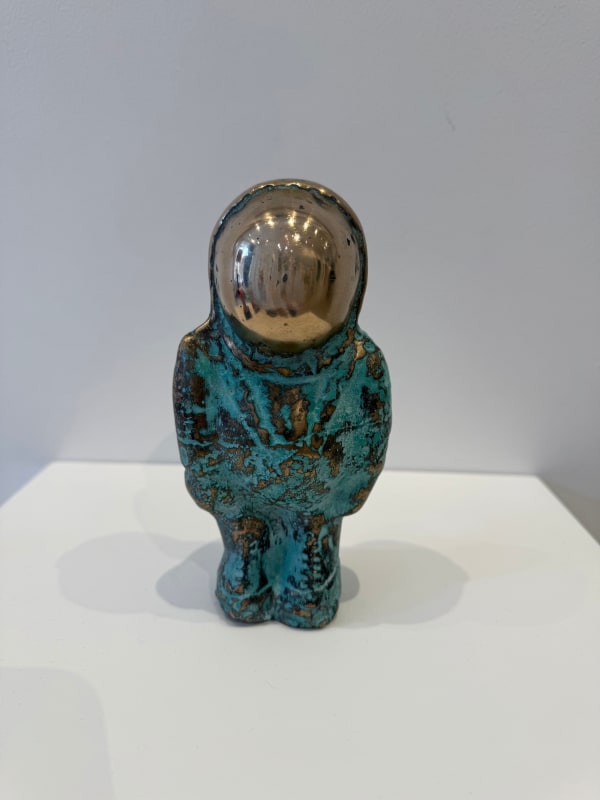In This Guide:
Standing before a bronze sculpture for the first time, you experience something paintings cannot offer. The work exists in your space, casting shadows, commanding attention through sheer physical presence. You can walk around it, discovering new perspectives with each step, watching how light transforms its surfaces throughout the day. Yet for many gallery visitors, sculpture remains mysterious. What makes bronze different from wood or stone? How do you interpret three-dimensional art? What should you look for when experiencing sculptural works?
This guide demystifies sculpture as an art form, helping you understand the materials, techniques, and traditions that shape contemporary sculptural practice. By learning to read the language of three-dimensional art, you'll develop confidence to engage with sculptural works on a deeper level, transforming gallery visits from uncertain browsing into meaningful encounters with artistic expression.
Whether you're considering your first sculpture purchase or seeking to enhance your appreciation of works you've encountered, this collector's guide will deepen your understanding of sculpture as both craft and art.
-
What Is Sculpture?
Sculpture represents the art of creating three-dimensional forms through carving, casting, assembling, or modelling. Unlike paintings that present a single viewpoint, sculpture exists in our physical world, inviting movement and multiple perspectives. This fundamental difference shapes how we experience sculptural art.
In its essence, sculpture transforms raw materials into expressive forms through the artist's vision and skill. The medium's physicality creates an immediate presence that paintings cannot match. A bronze figure commands space differently than a watercolour landscape; a carved wood piece carries the warmth and grain of living trees in ways that painted wood cannot.
Contemporary sculpture encompasses both traditional techniques passed down through centuries and innovative approaches using modern materials. From classical bronze casting to assemblages incorporating found objects, today's sculptors work within an expanded field of possibilities whilst drawing upon millennia of technical knowledge.
Understanding sculpture begins with recognising its unique relationship to space, light, and the viewer's movement. This interaction creates sculpture's particular magic, where the artwork changes as you change position, revealing new silhouettes, shadows, and details with each viewing angle.
Learn more about sculpture techniques and appreciation
-
-
Wood Sculpture
Wood sculpture offers an intimate, organic alternative to metal, connecting viewers to the natural world through material and process. The carving technique, where artists subtract material to reveal form, requires different thinking than additive processes like clay modelling.
Different woods provide varying characteristics: oak offers strength and prominent grain patterns, walnut provides rich colour and fine carving properties, whilst softer woods like basswood allow intricate detail work. The artist must work with the wood's natural structure, planning cuts to follow grain direction and avoid weakness in delicate areas.
Wood's organic nature creates both opportunities and challenges. The natural grain can enhance a sculpture's visual interest, but wood remains vulnerable to environmental changes. Proper humidity control prevents cracking, whilst protection from insects ensures longevity.
The warmth and tactile appeal of wood creates an immediate connection between artwork and viewer. Unlike bronze's cool perfection, wood sculpture often retains evidence of the carving process, creating direct links to the artist's hand and creative journey.
-
 Sue MundyWhite stonewareLignum IVHeight: 31 cm£ 160.00
Sue MundyWhite stonewareLignum IVHeight: 31 cm£ 160.00 -
Contemporary Approaches
Modern sculptors freely combine traditional techniques with innovative materials and methods. Mixed media sculptures might incorporate steel, glass, fabric, or found objects alongside traditional materials. This expansion reflects sculpture's evolution from purely representational work to conceptual expression.
Contemporary approaches include kinetic sculptures with moving parts, installation works that transform entire spaces, and assemblages that give new meaning to ordinary objects. These innovations expand sculpture's vocabulary whilst building upon traditional craft skills.
Explore our Sculpture Collection
Understanding Sculpture Styles & Approaches
Recognising different sculptural approaches enhances appreciation by revealing the artist's intent and method. Sculpture styles develop from how artists choose to represent or interpret their subjects.
Figurative sculpture focuses on human or animal forms, ranging from precise realism to expressive interpretation. Abstract sculpture emphasises form, texture, and spatial relationships over recognisable subjects. Contemporary sculpture often blurs these boundaries, creating works that suggest rather than depict.
Scale dramatically affects sculpture's impact. Monumental works command attention through sheer size, whilst intimate pieces invite close examination. The relationship between sculpture size and viewing space becomes part of the artistic statement.
Surface treatment reveals much about sculptural intent. Highly polished surfaces reflect light and surroundings, creating dynamic visual effects. Roughly textured surfaces emphasise the hand-working process and material character. Each choice contributes to the sculpture's meaning and emotional impact.
-
-
How To Appreciate Sculpture
Developing sculpture appreciation involves training your eye to read three-dimensional relationships whilst remaining open to emotional and intellectual responses. Unlike paintings viewed from fixed positions, sculpture demands physical engagement.
Begin by walking around the piece if possible, observing how the composition changes from different angles. Notice how light creates shadows that define form and reveal surface textures. Consider the sculptor's technical choices: smooth transitions versus sharp edges, polished versus rough surfaces, solid masses versus open voids.
Examine the relationship between the sculpture and its environment. How does it command or share space? Does it invite approach or maintain distance? These spatial relationships form part of the artistic statement.
Pay attention to material qualities and how they serve artistic intent. Bronze's reflective properties might enhance themes of permanence or grandeur. Wood's organic character could emphasise natural themes or human connection. Understanding these material associations deepens appreciation.
Consider scale and proportion. How does the sculpture's size affect its impact? Would it feel different, larger or smaller? These questions help you understand the artist's decisions about physical presence and viewer relationship.
Trust your physical and emotional responses whilst developing analytical skills. Sculpture's three-dimensional presence often creates visceral reactions that enhance intellectual understanding.
Discover our complete range of sculptural works
Displaying And Caring For Sculpture
Sculpture display requires consideration of safety, lighting, and spatial relationships. Proper presentation enhances the artwork whilst ensuring long-term preservation.
Pedestals provide physical stability and visual separation from surroundings. Choose heights that place the sculpture's focal points at comfortable viewing levels. Ensure pedestals can safely support the sculpture's weight, particularly important for stone and bronze works.
Lighting dramatically affects sculpture appreciation. Directional lighting enhances surface textures and creates engaging shadows. Avoid harsh spotlights that create glare on polished surfaces. Natural light beautifully animates bronze and stone but requires UV protection for sensitive materials.
Sculpture requires adequate space for proper appreciation. Allow sufficient room for viewers to move around freestanding pieces. Consider sightlines and traffic flow to prevent accidental contact with delicate elements.
Maintenance varies by material. Bronze benefits from occasional waxing to preserve patina, the thin surface layer that develops over time, giving the bronze its distinctive colour and character. Especially outdoor pieces. Stone requires only gentle dusting unless professionally cleaned. Wood sculpture needs stable humidity to prevent cracking.
Read our complete guide on how to care for artwork for detailed preservation advice
-
Sculptures By The Artists in this Article
-
Understanding Sculpture Art
Understanding sculpture enriches every encounter with three-dimensional art. Whether drawn to bronze's classical elegance, wood's organic warmth, or contemporary mixed-media innovations, developing appreciation for sculptural techniques and traditions enhances your cultural experience whilst providing foundation for confident collecting.
Scottish sculpture offers particular rewards, combining respect for traditional craft with contemporary innovation. The artists working today continue evolving this tradition whilst addressing current concerns and opportunities.
Remember that appreciation develops through exposure and practice. The more sculpture you encounter, the more your eye becomes trained to notice subtleties of technique and expression. Trust your instincts whilst remaining curious about new approaches.
Explore our Sculpture Collection
Scottish sculpture offers particular rewards, combining respect for traditional craft with contemporary innovation. The artists working today continue evolving this tradition whilst addressing current concerns and opportunities.
Meet our featured artists and discover their unique approaches
Remember that appreciation develops through exposure and practice. The more sculpture you encounter, the more your eye becomes trained to notice subtleties of technique and expression. Trust your instincts whilst remaining curious about new approaches.
Check our exhibitions page for upcoming sculpture showcases
Frequently Asked Questions
What is sculpture?
Sculpture is the art of creating three-dimensional forms through carving, casting, assembling, or modelling. Unlike two-dimensional art, sculpture exists in physical space and can be viewed from multiple angles, creating different experiences as you move around it.
How to clean a bronze sculpture?
Bronze sculpture requires gentle care to preserve its patina. Dust regularly with a soft cloth or brush. For outdoor bronze, apply microcrystalline wax annually to protect the patina. Never use metal polish or abrasives, as these will damage the protective patina layer.
How to display sculpture in home?
Choose stable surfaces or pedestals appropriate for the sculpture's weight. Ensure adequate space for viewing from multiple angles. Use appropriate lighting to enhance form and texture without creating glare. Consider the sculpture's scale relative to your room size.
What makes a sculpture unique?
Sculpture's three-dimensional presence creates spatial relationships impossible with two-dimensional art. Each sculpture occupies and transforms space differently, interacting with light and shadow whilst inviting physical movement around the work for complete appreciation.
Are sculptures a good investment?
Quality sculpture by established artists can appreciate in value, particularly bronze editions and unique works. However, collect primarily for personal enjoyment rather than investment potential. Consider factors like edition size, artist reputation, and condition when evaluating sculptural works.
Related Resources:
This guide was co-created in collaboration with Emile Haffmans of Art World Marketing and Finn Theunis of Orys in order to provide comprehensive and practical advice for understanding art forms and mediums.





